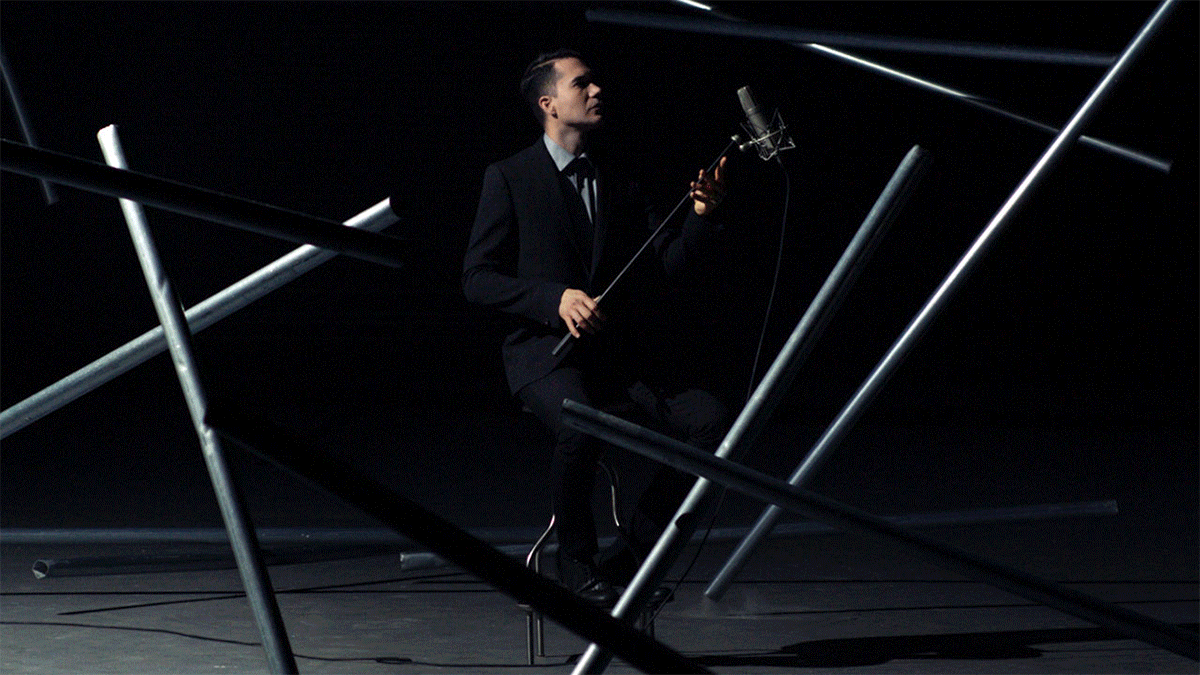In Carlo van de Roer’s photograph of Matthew Dear, the electro-dance musician, DJ, and producer sits on a stool in the middle of a stage. He’s holding the stand of a retro microphone in his hands, and surrounding him are several long metal pipes, fixed in mid-air. When you pan your mouse across the image, lights flicker across the stage, and those pipes---the less-than-glamorous hunks of construction material---start to levitate in synchronicity, as if performing a trance-like dance.
Van de Roer’s portrait of Dear, and his shots of other electronic music bands like Phantogram and Neon Indian, belong to a new kind of interactive photography. (The images you see here are GIFs; the interactive versions can be found here.) This style could be called something like “living light photography.” Van de Roer shot them with a high speed cinema camera powered by his own proprietary software, which can capture the movement of stage lights as they whip around the scene at 10,000 feet per second. (For reference, sound travels at 1,125 feet per second.) In these images, the subjects remain still while the sources of light move, in tandem with your computer’s mouse---almost as though you’re a lighting designer, working remotely from your laptop.
Van de Roer is a co-founder of Satellite Lab, a New York City company that develops imaging technology for filmmakers. He’s also a member of New Inc., the art and technology incubator affiliated with NYC’s New Museum, where he developed the technology that makes these photographs possible. Van de Roer identifies as an artist first, technologist second, and says he “was working with light, to play with the representation of time,” when he started thinking about this particular technique. “The idea was to be able to move light sources in this very high speed world of frozen imagery,” he says.
Here’s how it works: As the musicians---Dear, Phantogram, or Neon Indian---play, van de Roer sets up a camera. In this case, he used one of Vision Research’s insanely high-speed Phantom cameras. It connects to a silver box that van de Roer calls “the brain box,” and is controlled by software. As the camera quickly captures scenes of the performance, the “brain box” is communicating with lights set up around the stage. “Each frame the camera fires, a light fires,” van de Roer says. “It triggers an array of lights in a sequence,” moving at up to 10,000 feet a second. The camera captures all this---a split-second of light dancing across the stage---and creates short videos, similar to what Instagram's Boomerang app will generate. The final, interactive product is the result of code, written by van de Roer and his team. As the viewer hovers his mouse over the photo, and floats the cursor from left to right, the source of light moves. Elements of the photo that were previously in the shadow are suddenly alight.
Dynamic photos aren't exactly new; the high-speed Phantom Flex camera in particular has allowed filmmakers to slow down time, stretching five seconds into a three-and-a-half minute music video, or highlighting infinitesimal details in products, for the sake of advertising. Van de Roer's approach fits into this cadre of photography, but pushes the medium forward, both because his software's sophisticated ability to control and capture light, and because he's letting the viewer play a role.
The release of these photographs marks the launch of Music x Technology, a new website from Microsoft that will showcase art, music, and technology projects. Indeed, musicians are an ideal subject for van de Roer's portraits. Musical performances are a creative amalgam of light, sound, and motion, but typical concert photos can't convey all of that. These interactive portraits allow the viewer to participate---or, as van de Roer puts it, "activate" the light in the show. "The result is something that just exists through that audience-musician relationship," he says. "It's catalyzed through that technology."
